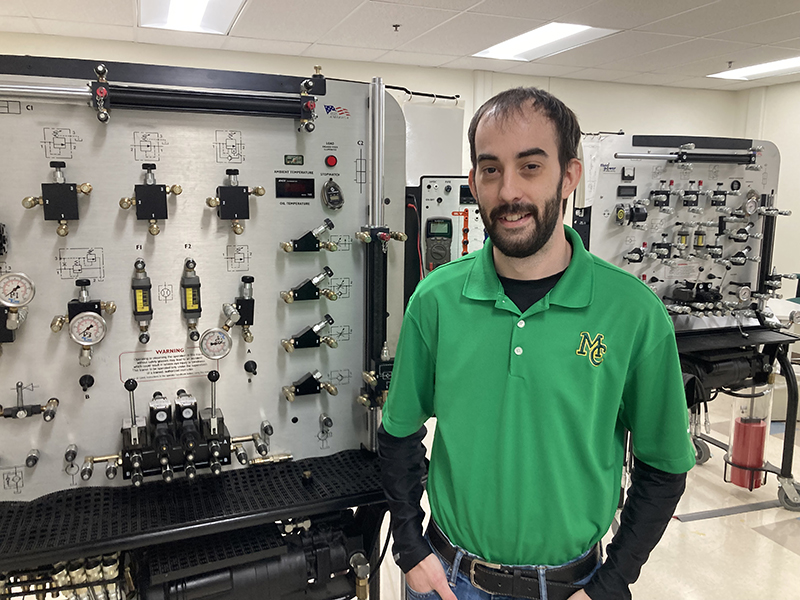 “If you would have asked me 10 years ago, I would have told you that there was no
way I would be a teacher,” Anthony Cummins said. “Now, look at me. I teach high
school classes in the morning and college classes in the afternoons and evenings,
and I love it!”
Cummins is an assistant professor of Energy Technology at Midland College (MC) and
also teaches dual credit Energy Technology courses to high school students through
the MC/MISD College and Careers Academy at the Midland College Advanced Technology
Center (ATC). However, Cummins explained that his original dream, which started when
he was in junior high school, was to be an automotive engineer.
“When I was growing up, my dad was always tinkering on his cars,” Cummins recalled.
“He had a 1984 Mustang that he bought when he was 20. He would pick me up from school
in that car, and I thought it was so cool. That’s why I enrolled in dual credit Automotive
Technology courses when I was in the 11th grade. I started taking those classes at
the ATC in 2007, and almost 17 years later, I now have four Mustangs—a 2003, 2007,
2011 and 2020. Just like my dad, I tinker with those cars in my spare time. And,
I’m still at the ATC, but this time I’m teaching.”
Cummins, who was a straight ‘A’ student in high school, excelled not only in traditional
classroom subjects, but also in hands-on dual credit Automotive Technology courses.
It didn’t take long for the professors to take notice of Cummins’ work ethic and
skill proficiency, and they hired him as a part-time lab assistant at the ATC while
he was in high school.
“My job was to check out tools to the students and then check them back in,” he said.
“If I didn’t get all the tools back after class, I had to go out in the shop and
find them.”
Cummins graduated from Lee High School (now Legacy High School) in 2009 and then continued
taking classes at Midland College, both Automotive Technology courses and core curriculum
courses. He also was promoted from Lab Assistant to Lab Instructor. He graduated
from Midland College in 2012 with two associate degrees—an Associate of Applied Science
degree in Automotive Technology and an Associate of Science General Studies degree.
He then transferred to the University of Texas Permian Basin (UTPB) and continued
to work as a part-time Automotive Technology lab instructor at the ATC.
“I guess I could have gotten another part-time job while I was in college, but I really
liked working with the students and helping them with their skills,” he said. “I
still wanted to be an engineer; however, I was thinking that maybe I should look at
another field other than automotive because I learned that most automotive engineering
jobs at the time were in the Detroit area, and I wasn’t thrilled about the prospect
of moving to Detroit.”
After graduating with a bachelor’s degree in Mechanical Engineering in 2015, Cummins
was hired as a completion tools engineer for Halliburton where he gained experience
in the oil and gas industry.
“It was a good job, and I liked it, but I really missed teaching and working with
students,” he said. “So, in November 2017, when I learned that Midland College needed
someone with an engineering background to teach in the Energy Technology program,
I decided to give teaching as a full-time career a try, and that is one of the best
decisions I ever made.”
Cummins explained that most of the Energy Technology courses he teaches focus on automation
and programmable logic controllers (PLCs). He said that technology in the energy
industry is rapidly evolving, so it’s important to have a thorough understanding of
how the technology works. Students in high school who are interested in Energy Technology
can begin the program in the 10th grade at their high school campuses. Then in the
11th grade, they travel from their home campus to the ATC for dual credit courses.
“A student who begins the Energy Technology program in the 10th grade can actually
obtain a Level 1 Certificate when they graduate from high school,” Cummins said. “Then,
if they continue the Energy Technology program after high school graduation, they
can progress to a Level 2 certificate and finally an Associate of Applied Science
degree. Most of the students who graduate from the program are hired as automation
technicians, instrumentation and electrical technicians, pumpers and lease operators.
“I really enjoy passing my knowledge to students, and it gives me a great deal of
satisfaction when I see them grasp a concept. I am still teaching hands-on skills,
just like I learned in my Automotive Technology courses. ‘Hands-on’ learning was
how I learned best when I was in school, and that is also how the majority of my students
learn best. Now, as a professor at the ATC, I can still see things from a student’s
perspective. I am honored to be teaching at Midland College. This may sound trite,
but I truly believe that teaching is my calling.”
|
